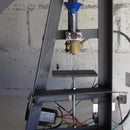Introduction: Rebuilding a Spoked Wheel for the Royal Enfield Bullet:Part 2
Part 2: Truing the Wheel
Part 1 dealt with the install and pattern of the spokes. -->Here
This part deals with the process of centering the wheel in both planes, vertical and horizontal and ensuring that the wheel is also centered between the forks (front) or swingarm (rear).
While the 1st part went fairly quickly, approx 1 hr, this part took me fairly long, approx 2.5 hrs
budget your time accordingly.
Safety is always a big issue, so to that end I tied the center stand to the front of the bike so that it couldnt fold.
Failure to do will cause the bike to collapse onto the sump or exhaust damaging either or both.
Step 1: Centering the Wheel on the Bike
First I center the wheel on the bike in either the front forks or rear swingarm depending on which one I'm tackling.
In this case its the rear wheel so back on the bike it goes, setting it up as though ready to ride.
In the case of the Enfield its got adjustable cams (notched) to ensure proper chain tension and that the wheel tracks straight.
I find it easier to remove the top of the RHS shock and fold it down, as well as remove the mudguard assembly for easy access to the wheel and swingarm assembly.
I've installed a threaded rod to act as a pointer in the lower mudguard mounting hole.
Step 2: In Closer
A top view of pointer and rim, I set the valve hole (good ref point) of the rim next to the pointer and center it in relation to the swingarm.This will most likely take some tweaking of the spokes to achieve.
Step 3: Vertical Adjusting
I like to use the M pattern when doing vertical adjustment, well it looks like an M but I spose it could be a W too.
Lets say that the rim when rotated has the highest point at A you would then need to tighten both spoke sets at A, the red set and the blue set to pull down the rim equally at A. Of course by the same token you would need to loosen both sets, pink and green at B to give the rim space to move down.
I usually tighten a quarter turn at a time, yes it does take longer but the chance of me warping the heck outta my rim is less.
I proceed with this rotating to find the high spot and then adjusting till the entire rim is almost within the 0.5mm spec for out of round, then I move on to the side to side deviation, that spec is also 0.5mm.
Of course if speed is your thing then smaller tolerances would be even more desirable.
Step 4: Side Adjustments
For this adjustment I rotate the rim looking for deflection to the left, my reference pointer being on the right, and then tighten the spoke at that point that goes to the right side of the hub, as well as a spoke on either side of the identified spoke, making sure they also go to the right side of the hub.
This serves to pull the rim over to the right, making sure not to pull the rim further to the right than the valve hole which was my ref point, otherwise the rim/wheel assembly wont be centered in the swingarm/front forks.
In the diagram, if the rim is too far to the left A then I tighten the black spoke going to the right side of the hub.
Likewise tightening red A spokes would serve to pull the rim over to the left.
Step 5: And Finally
this gap is too large, I use a piece of paper to barely slip through as a reference.
Here I will need to tighten spokes going to the right side of the hub to pull the rim closer to the right.
Once the rim is centered to my satisfaction then I work my way around the rim giving every spoke a quarter turn, and then once more for good measure. This serves to tension the spokes properly and now they should have a nice ring to them. One last check to make sure everything is still centered and then its on to the tyre installation.
I rub my thumb around the rim before installing the tube/tyre to check for any high spokes ( must be filed down) or sharp edges that could cut the tube, saves work later on repairing punctures, and also put back the rim tape that was covering the spoke nipples
To finish off I tap around the rim to sort of seat the spokes. Same sort of thing achieved by installing tube and tyre and inflating, then bouncing the wheel on the ground, gently, not like a lunatic. A wheel has a strange knack of bouncing in an unpredictable way like a rugby ball, so its probably better to use a rubber mallet.
If all this is doesnt make sense, then theres another well worded spoked wheel repair site here













